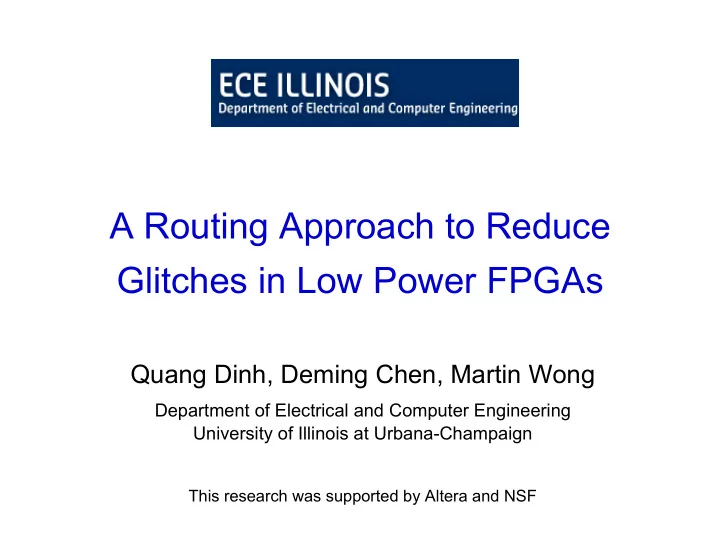

A Routing Approach to Reduce Glitches in Low Power FPGAs Quang Dinh, Deming Chen, Martin Wong Department of Electrical and Computer Engineering University of Illinois at Urbana-Champaign This research was supported by Altera and NSF
Outline � Introduction � Background � Routing Approach � Path-Finding Algorithm � Results
Dynamic Power and Glitch � Dynamic Power � 67% of total power (Stratix II FPGAs) � Glitch � Up to 60% of total dynamic power � Glitch Reduction � Lower Dynamic Power
Related Works � High-Level � Logic decomposition [Monteiro et al., 1998] � RTL synthesis [Raghunathan et al., 1999] � Not applicable to FPGA � Gate freezing [Benini et al., 2000] � Delay insertion [Raghunathan et al., 1999] � FPGA specific � GlitchMap [Cheng et al., 2007] � GlitchLess [Jamoureux et al., 2007]
FPGA Interconnect � Island-Style FPGA � Interconnect delay is more significant than logic delay � Programmable interconnects with fixed delays � Rich, under-used interconnect [Betz et al., 1999] resource
Routing Approach � Reduce Glitches by balancing input arrival times � By routing through paths with desired delays � Lengthen paths of early-arriving inputs � No Architectural Modification � Applied to existing FPGAs � Do not affect critical path delay
FPGA Routing Architecture [Betz et al., 1999] � Routing resource graph � Assumption: Buffered Switches � True for commercial FPGAs (boost performance) � Linear delay model for paths
Algorithm Overview � Get an valid routing solution (VPR router) � Reduce Glitches by Balancing certain source- sink pairs � Selection and Ordering of pairs � Rip-up and re-route each pair � Reroute with Path-Finding Algorithm � Find path with desired delay
Selection Criteria � Power overhead due to longer path � More capacitance, more buffers Switching Reduction 1.2 � Balance only beneficial Capacitance Increase 1 inputs 0.8 0.6 0.4 � Heuristic: Balancing inputs 0.2 of 1 st -level clusters 0 1st Level 2nd Level All
Ordering Criteria � LUT Input Weighting � Likelihood of glitch generation � Signal probability of Boolean difference � Balancing overhead � Prefer small increase delays over large increase � Path ranking
Path-Finding Algorithm � Inputs: � Routing-resource graph (V, E) with delay information � Source-sink pair ( s , t ) � Desired delay range d± Δ � Output: � Path from s to t with desired delay � Not always has a solution s t
Motivation � Try every paths: exponential complexity � Heuristic: Select a manageable subset of paths � Polynomial complexity � Still provide reasonable quality of results � Wide range of path lengths
Motivation � Efficient path algorithm: shortest path � Find only path with d smallest delay � Detour t s � Combine shortest paths � Increase path delay
Motivation d � Efficient path algorithm: shortest path � Find only path with smallest delay � Detour t s � Combine shortest paths � Increase path delay � Problem: overlapping
Candidate Paths t' Set S s s t Set T � Set S: vertices closer to s � Set T: vertices closer to t � ( s ’, t ’): direct connection (edge) � Guarantee no overlapping
Glitch-Reducing Framework Run timing-driven VPR router to get a routing solution for each 1-st level CLB input get desired balanced delay compute path rank end Sort these inputs by their rank for each input rip-up current path use path-finding algorithm to find a path with the desired delay if can not find such a path restore the ripped-up path end end
Experiment Settings � 20 largest circuits from MCNC and ISCAS89 � Timing-driven place and route by VPR � 4-LUT, cluster size 4 � Power simulator fpgaEVA-LP2 [Li et al., 2005] � Dynamic power � Glitch power � Switching activity
Circuits Dynamic Power (mW) Impr. Runtime (seconds) (%) without with without with Results alu4 38.20 35.29 6.45 22.8 42.7 apex2 40.13 39.75 1.26 34.6 82.4 apex4 17.65 16.20 8.10 20.9 22.2 des 67.53 59.95 9.92 25.9 101.9 ex1010 39.04 32.47 18.60 187.4 194.3 exp5p 19.78 15.83 16.87 15.1 16.8 misex3 32.33 29.19 7.67 19.2 32.4 pdc 33.11 29.35 12.28 212.3 243.4 seq 34.92 32.92 5.42 28.6 41.1 spla 33.80 31.09 8.76 139.2 148.1 C1355 3.71 3.24 12.04 0.6 1.1 C1908 7.82 7.13 8.94 1.0 1.5 C2670 12.64 11.87 5.24 4.0 8.3 C3540 21.54 19.05 11.45 3.5 3.8 C432 2.68 2.44 7.81 0.4 0.6 C499 3.59 3.07 13.78 0.6 0.8 C5315 34.08 31.03 8.82 7.2 14.0 C6288 73.20 59.39 18.84 4.9 6.1 C7552 43.51 38.55 11.40 9.1 17.9 C880 3.49 3.42 3.33 0.7 0.8 36.9 49.0 average 9.85
Circuits Reduction in Reduction in Increase in Glitch Power (%) Switching Activity (%) Wire Length (%) Results alu4 38.89 8.01 5.51 apex2 7.48 5.23 9.45 20.35 10.18 7.10 apex4 des 20.81 11.94 8.44 ex1010 28.50 22.94 9.41 exp5p 25.79 21.02 8.43 misex3 28.43 9.35 6.36 pdc 31.63 15.26 7.29 26.77 6.96 4.50 seq spla 16.17 10.96 7.50 C1355 34.76 15.22 7.80 C1908 21.25 11.52 7.62 C2670 19.09 6.57 4.68 C3540 20.92 14.21 9.99 21.82 9.93 6.62 C432 C499 33.45 17.75 8.62 C5315 18.82 11.10 7.42 C6288 18.05 22.84 9.23 C7552 21.32 13.98 9.74 C880 13.82 6.67 8.27 average 23.41 12.58 7.70
Conclusions � Glitch reduction in FPGA through routing � CAD approach, not require architectural modification � 9.8% average of dynamic power reduction � Efficient Path-finding algorithm � A small, efficient subset of possible paths � Can be combined with other techniques � GlitchMap � GlitchLess
Recommend
More recommend